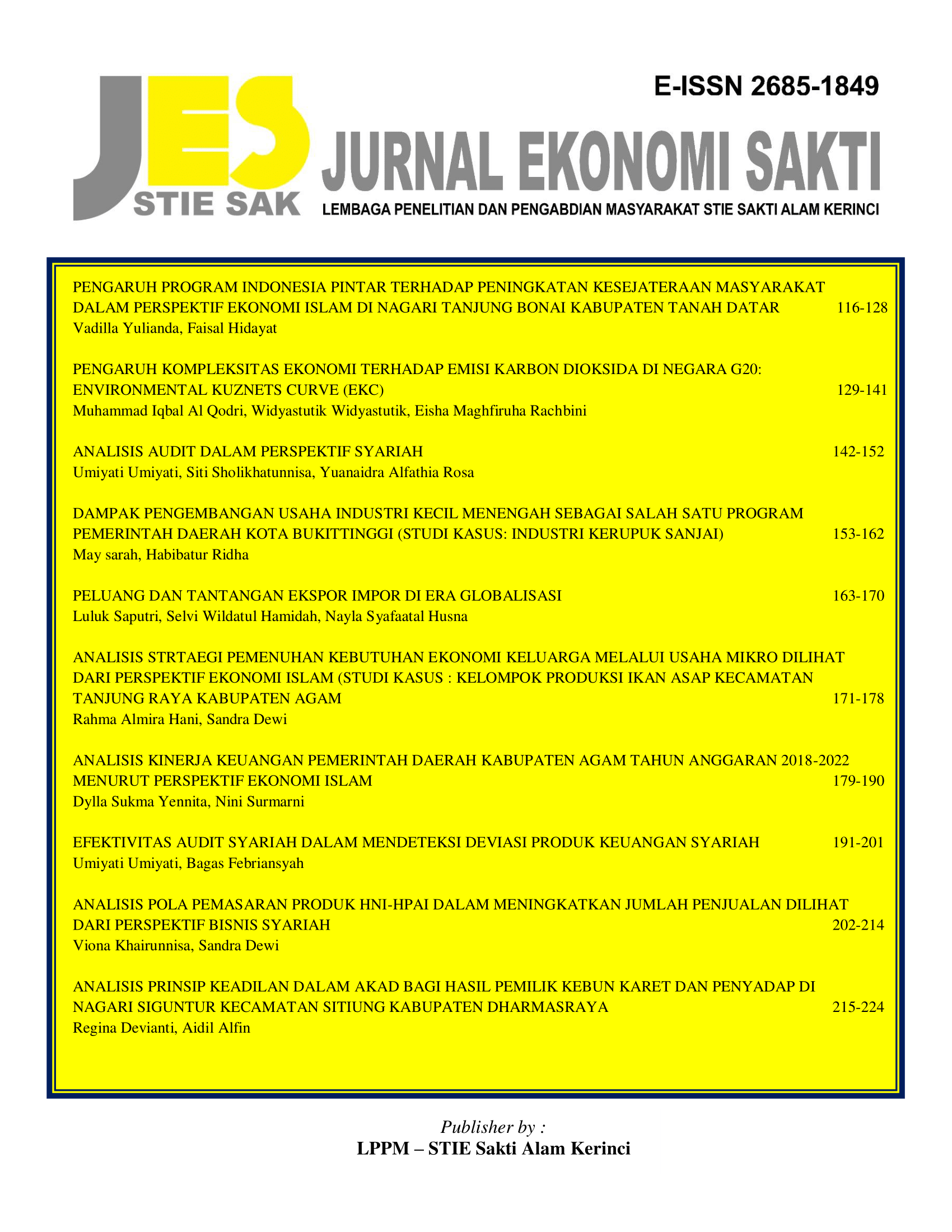PENGARUH KOMPLEKSITAS EKONOMI TERHADAP EMISI KARBON DIOKSIDA DI NEGARA G20: ENVIRONMENTAL KUZNETS CURVE (EKC)
DOI:
https://doi.org/10.36272/jes.v13i2.336Keywords:
carbon dioxide, economic complexity, EKC, FDI, renewable energyAbstract
Economic growth not only increases the size of the economy, but also the variety of technology used in production, which are captured by the Economic Complexity Index (ECI) approach. Many countries seek to increase its economic complexity through the industrial sector to accelerate economic growth. On the other hand, energy sources from coal and petroleu so resulting in high emissions. The objective of this study is to analyze whether economic complexity can reduce emissions by using the Environmental Kuznets Curve (EKC) approach. The research method used are Fully Modified OLS (FMOLS) and Dynamic OLS (DOLS) for 18 selected G20 countries from 1995-2020. This study found that economic complexity reduced carbon dioxide emissions after passing the turning point in the long run, in the case of both developed and developing G20 countries. In addition, for developed G20 countries that FDI and renewable energy contributed to reduce emissions. However, for developing G20 countries that FDI and renewable energy increased carbon dioxide emissions. This study suggested that low emissions technology innovation need to be optimized through FDI, for developed G20 countries. Furthermore, for developing G20 countries, strengthening G20 cooperation for energy transition, particularly in low emission investment financing, is needed.
Downloads
References
Bilgili F, Kocak E, Bulut U. 2016. The dynamic impact of renewable energy consumption on CO2 emissions: A revisited Environmental Kuznets Curve approach. Renewable and Sustainable Energy Reviews. 54: 838-845. https://doi.org/10.1016/j.rser.2015.10.080
Destek MA, Sinha A. 2020. Renewable, non-renewable energy consumption, economic growth, trade openness and ecological footprint: evidence from organisation for economic Co-operation and development countries. Journal of Cleaner Production. 242. https://doi.org/10.1016/j.jclepro.2019.118537
[EDGAR] Emissions Database for Global Atmospheric Research. 2023. GHG emissions of all world countries. [internet]. [diakses Desember 2023]. Tersedia pada: https://edgar.jrc.ec.europa.eu/report_2023
[EIA] U.S. Energy Information Administration. 2023. Consumption Primary Energy in nuclear, renewables, and other. [internet]. [diakses Januari 2024]. Tersedia pada: https://www.eia.gov/international/data/world
Elhorst JP. 2021. Cross-Sectional Dependence and Spillovers in Space and Time: Where Spatial Econometrics and Global VAR Models Meet. Journal of Economic Surveys. 35(1): 192–226. https://onlinelibrary.wiley.com/doi/pdf/10.1111/joes.12391
Grossman GM, Krueger AB. 1991. Environmental Impacts of a North American Free Trade Agreement. In NBER Working Papers (No. 3914; NBER Working Papers). National Bureau of Economic Research, Inc. https://www.nber.org/papers/w3914
Hasan MB, Wieloch J, Ali MS, Zikovic S, Uddin GS. 2023. A new answer to the old question of the environmental Kuznets Curve (EKC). Does it work for BRICS countries?. Resources Policy 87. https://doi.org/10.1016/j.resourpol.2023.104332
Hausmann R, Hidalgo CA, Bustos S, Coscia M, Simoes A, Yildirim MA. 2013. The Atlas of Economic Complexity: Mapping Paths to Prosperity. USA: MIT Press. Tersedia pada: growthlab.hks.harvard.edu/sites/projects.iq.harvard.edu/files/growthlab/files/atlas_2013_part1.pdf
Hoeriyah L, Nuryartono N, Pasaribu S. 2022. Economic Complexity and Sustainable Growth in Developing Countries. Economics Development Analysis Journal. 11(1): 23-33. https://doi.org/10.15294/edaj.v11i1.47294
Huang J, Li X, Wang Y, Lei H. 2021. The effect of energy patents on China’s carbon emissions: evidence from the STIRPAT model. Technological Forecasting and Social Change. 173. https://doi.org/10.1016/j.techfore.2021.121110
[IEA] International Energy Agency. 2020. Policies database. [internet]. [diakses Februari 2024]. Tersedia pada: https://www.iea.org/policies
[IMF] International Monetary Fund. 2023. Country Composition of WEO Groups. [internet]. [diakses Desember 2023]. Tersedia pada: https://www.imf.org/en/Publications/WEO/weo-database/2023/April/groups-and-aggregates
[IRENA] International Renewable Energy Agency. 2022. INNOVATION OUTLOOK RENEWABLE AMMONIA. [internet]. [diakses Februari 2024]. Tersedia pada: https://www.irena.org/-/media/Files/IRENA/Agency/Publication/2022/May/IRENA_Innovation_Outlook_Ammonia_2022.pdf
Jebli MB, Madaleno M, Schneider N, Shahzad U. 2022. What does the EKC theory leave behind? A state-of-the-art review and assessment of export diversification-augmented models. Environmental Monitoring and Assessment. 194(414). https://doi.org/10.1007/s10661-022-10037-4
Kao C, Chiang MH. 2001. On the estimation and inference of a cointegrated regression in panel data. Baltagi, B.H., Fomby, T.B. and Carter Hill, R. (Ed.) Nonstationary Panels, Panel Cointegration, and Dynamic Panels (Advances in Econometrics, Vol. 15), Emerald Group Publishing Limited, Leeds, pp. 179-222. https://doi.org/10.1016/S0731-9053(00)15007-8
Kuznets S. 1955. Economic Growth and Income Inequality. The American Economic Review. 45: 1–28. https://assets.aeaweb.org/asset-server/files/9438.pdf
Lu Z, Gozgor G, Mahalik MK, Padhan H, Yan C. 2022. Welfare gains from international trade and renewable energy demand: Evidence from the OECD countries. Energy Economics 112. https://doi.org/10.1016/j.eneco.2022.106153
Nababan R. 2013. Memahami Economic Complexity Index (ECI) Bagian I ECI Sebagai Indeks Pembangunan Ekonomi Berbasis Produk. Jurnal Administrasi Bisnis. 9(2): 159–169. DOI: https://doi.org/10.26593/jab.v9i2.1212.%25p
Neagu O. 2019. The link between economic complexity and carbon emissions in the European Union countries: a model based on the Environmental Kuznets Curve (EKC) approach. Sustainability. 11(17). https://doi.org/10.3390/su11174753
Neagu O, Teodoru MC. 2019. The Relationship between Economic Complexity, Energy Consumption Structure and Greenhouse Gas Emission: Heterogeneous Panel Evidence from the EU Countries. Sustainability. 11(2). https://doi.org/10.3390/su11020497
[OEC] Observatory of Economic Complexity. 2023. Economic Complexity Index Country Rankings. [internet]. [diakses Desember 2023]. Tersedia pada: https://oec.world/en/rankings/eci/hs6/hs96?tab=ranking
Saqib N, Dinca G. 2023. Exploring the asymmetric impact of economic complexity, FDI, and green technology on carbon emissions: Policy stringency for clean-energy investing countries. Geoscience Frontiers. https://doi.org/10.1016/j.gsf.2023.101671
[UNEP] UN Environment Programme. 2023. Global Temperature Change. [internet]. [diakses Desember 2023]. Tersedia pada: https://data.unep.org/climate/essential-climate-variables-ecv/global-temperature-change
Ye C, Zheng Y, Han X, Chen S. 2023. Can increased economic complexity and reduced carbon emissions of the logistics industry go hand in hand? Evidence from countries along the Belt and Road. Advances in Climate Change Research. 14(5): 789-797. https://doi.org/10.1016/j.accre.2023.09.012
Zhao J, Shahbaz M, Dong X, Dong K. 2021. How does financial risk affect global CO2 emissions? The role of technological innovation. Technological Forecasting and Social Change. 168. Tersedia pada: https://doi.org/10.1016/j.techfore.2021.120751


